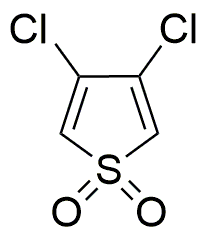3,4-Dichlorothiophene 1,1-dioxide is widely utilized in research focused on:
- Pesticide Development: This compound serves as a key intermediate in the synthesis of various agrochemicals, enhancing crop protection against pests and diseases.
- Pharmaceuticals: It is used in the development of pharmaceutical agents, particularly in creating compounds with potential anti-inflammatory and antimicrobial properties.
- Material Science: The compound is explored for its role in developing advanced materials, such as conductive polymers, which are essential in electronics and sensor technologies.
- Environmental Applications: It is studied for its potential in environmental remediation processes, particularly in breaking down pollutants in contaminated soil and water.
- Research in Organic Chemistry: This chemical is frequently employed in organic synthesis, allowing researchers to explore new reactions and develop novel compounds with unique properties.
General Information
Properties
Safety and Regulations
Applications
3,4-Dichlorothiophene 1,1-dioxide is widely utilized in research focused on:
- Pesticide Development: This compound serves as a key intermediate in the synthesis of various agrochemicals, enhancing crop protection against pests and diseases.
- Pharmaceuticals: It is used in the development of pharmaceutical agents, particularly in creating compounds with potential anti-inflammatory and antimicrobial properties.
- Material Science: The compound is explored for its role in developing advanced materials, such as conductive polymers, which are essential in electronics and sensor technologies.
- Environmental Applications: It is studied for its potential in environmental remediation processes, particularly in breaking down pollutants in contaminated soil and water.
- Research in Organic Chemistry: This chemical is frequently employed in organic synthesis, allowing researchers to explore new reactions and develop novel compounds with unique properties.
Documents
Safety Data Sheets (SDS)
The SDS provides comprehensive safety information on handling, storage, and disposal of the product.
Product Specification (PS)
The PS provides a comprehensive breakdown of the product’s properties, including chemical composition, physical state, purity, and storage requirements. It also details acceptable quality ranges and the product's intended applications.
Certificates of Analysis (COA)
Search for Certificates of Analysis (COA) by entering the products Lot Number. Lot and Batch Numbers can be found on a product’s label following the words ‘Lot’ or ‘Batch’.
*Catalog Number
*Lot Number
Certificates Of Origin (COO)
This COO confirms the country where the product was manufactured, and also details the materials and components used in it and whether it is derived from natural, synthetic, or other specific sources. This certificate may be required for customs, trade, and regulatory compliance.
*Catalog Number
*Lot Number
Safety Data Sheets (SDS)
The SDS provides comprehensive safety information on handling, storage, and disposal of the product.
DownloadProduct Specification (PS)
The PS provides a comprehensive breakdown of the product’s properties, including chemical composition, physical state, purity, and storage requirements. It also details acceptable quality ranges and the product's intended applications.
DownloadCertificates of Analysis (COA)
Search for Certificates of Analysis (COA) by entering the products Lot Number. Lot and Batch Numbers can be found on a product’s label following the words ‘Lot’ or ‘Batch’.
*Catalog Number
*Lot Number
Certificates Of Origin (COO)
This COO confirms the country where the product was manufactured, and also details the materials and components used in it and whether it is derived from natural, synthetic, or other specific sources. This certificate may be required for customs, trade, and regulatory compliance.


